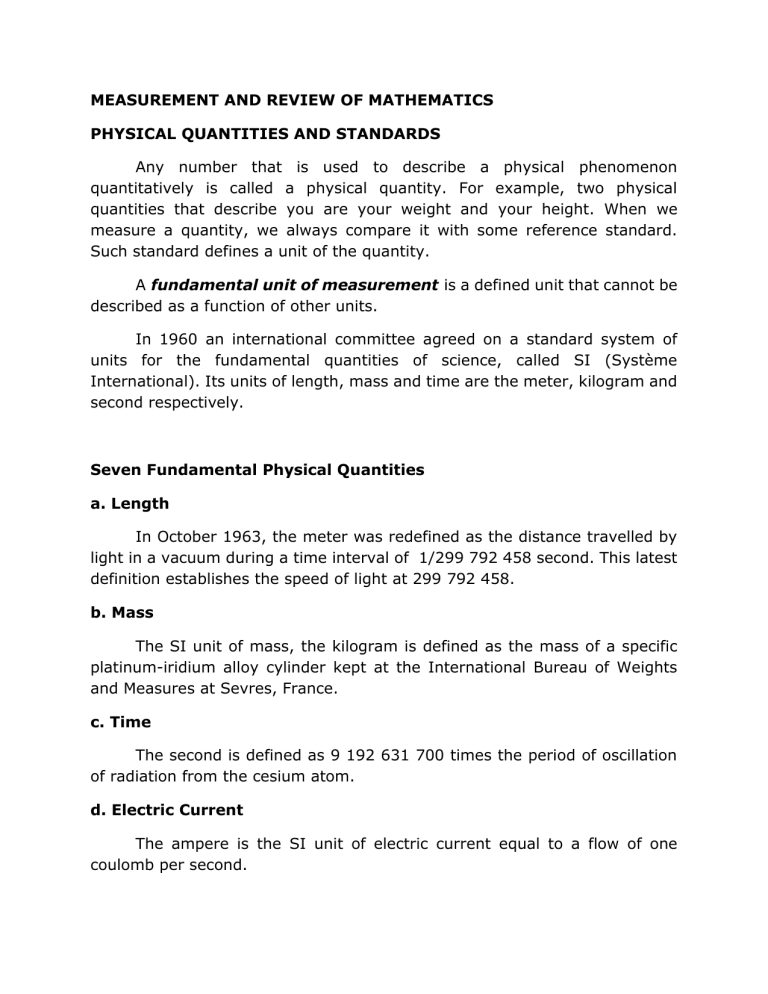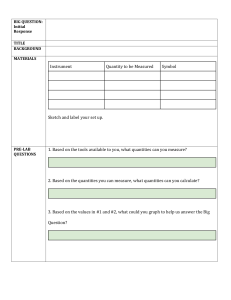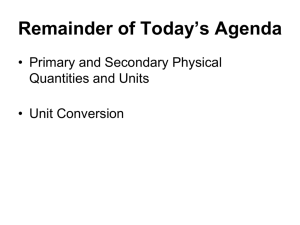
MEASUREMENT AND REVIEW OF MATHEMATICS PHYSICAL QUANTITIES AND STANDARDS Any number that is used to describe a physical phenomenon quantitatively is called a physical quantity. For example, two physical quantities that describe you are your weight and your height. When we measure a quantity, we always compare it with some reference standard. Such standard defines a unit of the quantity. A fundamental unit of measurement is a defined unit that cannot be described as a function of other units. In 1960 an international committee agreed on a standard system of units for the fundamental quantities of science, called SI (Système International). Its units of length, mass and time are the meter, kilogram and second respectively. Seven Fundamental Physical Quantities a. Length In October 1963, the meter was redefined as the distance travelled by light in a vacuum during a time interval of 1/299 792 458 second. This latest definition establishes the speed of light at 299 792 458. b. Mass The SI unit of mass, the kilogram is defined as the mass of a specific platinum-iridium alloy cylinder kept at the International Bureau of Weights and Measures at Sevres, France. c. Time The second is defined as 9 192 631 700 times the period of oscillation of radiation from the cesium atom. d. Electric Current The ampere is the SI unit of electric current equal to a flow of one coulomb per second. e. Temperature The kelvin is the fraction 1/273.16 of the thermodynamic temperature of the triple point of water. f. Amount of Substance The SI unit of amount of substance is the mole equal to the quantity containing as many elementary units as there are atoms in 0.012 kg of carbon-12. g. Luminous Intensity The SI unit of luminous intensity is the candela. One candela in a given direction, of a source that emits monochromatic radiation of frequency 540 x 1012 Hz and has a radiant intensity in that direction of 1/683 watt per steradian. Derived Quantities Many other quantities can be derived out of the combination of the basic quantities. For instance a speed is the ratio of a length by a time. Acceleration is the ratio of a speed by a time. And a force is the multiplication of acceleration by mass. Unit Prefixes In the metric system these units are related to the fundamental units (or, in the case of mass, to the gram) by multiples of 10 or 1/10. Thus one kilometer (1 km) is 1000 meters and one centimeter (1 cm) is 1/100 meter. We usually express multiples of 10 or 1/10 in exponential notation: 1000 = 103, 1/1000 = 10-3. With this notation, 1 km = 103 m and 1 cm = 10-2 m. The names of the additional units are derived by adding a prefix to the name of the fundamental unit. For example, the prefix "kilo-" abbreviated k, always means a unit larger by factor of 1000; thus 1 kilometer = 1 km = 103 meters = 103 m 1 kilogram = 1 kg = 103 grams = 103 g 1 kilowatt = 1 kW = 103 watts = 103 W 1 kilogram = 2.20462 pounds 1. If a car is travelling at a speed of 28.0 m/s, is the driver exceeding the speed limit of 55.0 mi/h? 2. The traffic light turns green and the driver of a high performance car slams the accelerator to the floor. The accelerometer registers 22.0 m/s2. Convert this reading to km/min2. 3. Convert 4.50 x 103 kg/m3 to g/cm3. 4. Convert 1228.0 km/h to m/s. 5. The world's largest cut diamond is the First Star of Africa (mounted in the British Royal Sceptre and kept in the Tower of London). Its volume is 1.84 cubic inches. What is its volume in cubic centimeters? 6. An ore loader moves 1200 tons/hr from a mine to the surface. Convert this rate to pound per second. 7. A rectangular building lot has a width of 75.0 ft and a length of 125 ft. Determine the area of this lot in square meters. 8. One bottle holds 295 dL while another one holds 28,000 mL. What is the difference in capacity between the two bottles? 9. A two-liter bottle contains 87 centiliters of oil and 4.1 deciliters of water. How much more liquid is needed to fill the bottle? 10. Mary had a lemonade stand. On one day she sold 117 cups of lemonade. If each cup contained 226 milliliters of the beverage, how many liters did she sell in all? 11. One week while she was training for a marathon, Lucy ran a total of 131 kilometers. If she ran every day of the week, how many meters did she run each day? 12. At the Burger Hut each patty contains 200 grams of ground beef. If on one busy day, 467 burgers were sold, how many kilograms of ground beef were used? 13. A factory produced 175 liters of perfume one day. The perfume was put into 2 different sized bottles. First, 500 bottles were filled with 300 milliliters each. The remainder of the perfume was put into bottles which held 250 milliliters each. How many of the smaller bottles were filled? 14. A swimming pool is 50 meters long. Each day a swimmer swam a total of 75 lengths of the pool for practice. How many kilometers did she swim over a 15 day period? 15. Lois wants to send a box of oranges to a friend by mail. The box of oranges cannot exceed a mass of 10 kg. If each orange has a mass of 200g, what is the maximum number she can send? 16. Peter is overweight. He is 105 kg. His aim is to lose 500 g per week. If he manages this, how many weeks will it be until he is 90 kg? 17. A peach weighs 65 grams. If you buy 10 peaches and they sell for $5.50 per kilogram, how much will they cost? 18. John wanted to impress his friends by winning the 200 yard dash at the track meet. If he runs 8.2 feet per second, how long will it take him to complete the dash? (round to the nearest tenth) 19. Kelsey has a new baby brother! He weighs 8 lbs 3 oz. The doctor said the baby should gain about 5 ounces per week. At that rate, how much should the baby weigh in 3 months (12 weeks)? In lb and oz 20. The police went on a wild chase to catch a man speeding through town in a black pick-up truck. At times their speeds exceeded eighty-five miles per hour. At that rate, how many miles would the car go in 20 minutes? (round to the nearest whole mile)




